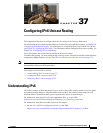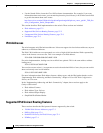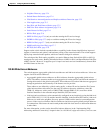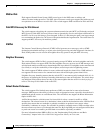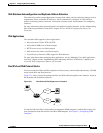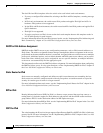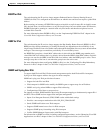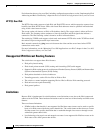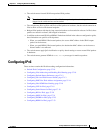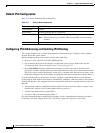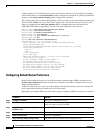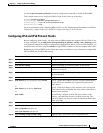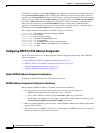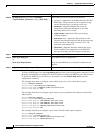
37-9
Catalyst 3560 Switch Software Configuration Guide
OL-8553-06
Chapter 37 Configuring IPv6 Unicast Routing
Configuring IPv6
• The switch cannot forward SNAP-encapsulated IPv6 packets.
Note There is a similar limitation for IPv4 SNAP-encapsulated packets, but the packets are
dropped at the switch and are not forwarded.
• The switch routes IPv6-to-IPv4 and IPv4-to-IPv6 packets in hardware, but the switch cannot be an
IPv6-to-IPv4 or IPv4-to-IPv6 tunnel endpoint.
• Bridged IPv6 packets with hop-by-hop extension headers are forwarded in software. In IPv4, these
packets are routed in software, but bridged in hardware.
• In addition to the normal SPAN and RSPAN limitations defined in the software configuration guide,
these limitations are specific to IPv6 packets:
–
When you send RSPAN IPv6-routed packets, the source MAC address in the SPAN output
packet can be incorrect.
–
When you send RSPAN IPv6-routed packets, the destination MAC address can be incorrect.
Normal traffic is not affected.
• The switch cannot apply QoS classification or policy-based routing on source-routed IPv6 packets
in hardware.
• The switch cannot generate ICMPv6 Packet Too Big messages for multicast packets.
Configuring IPv6
These sections contain this IPv6 forwarding configuration information:
• Default IPv6 Configuration, page 37-10
• Configuring IPv6 Addressing and Enabling IPv6 Routing, page 37-10
• Configuring Default Router Preference, page 37-12
• Configuring IPv4 and IPv6 Protocol Stacks, page 37-13
• Configuring DHCP for IPv6 Address Assignment, page 37-14
• Configuring IPv6 ICMP Rate Limiting, page 37-18
• Configuring CEF for IPv6, page 37-18
• Configuring Static Routes for IPv6, page 37-19
• Configuring RIP for IPv6, page 37-20
• Configuring OSPF for IPv6, page 37-21
• Configuring EIGRP for IPv6, page 37-23
• Configuring HSRP for IPv6, page 37-23



